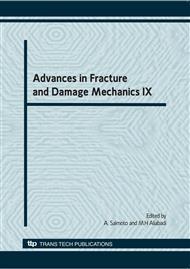p.657
p.661
p.665
p.669
p.673
p.677
p.681
p.685
p.689
Stress Intensity Factors for Surface Semi-Elliptical Crack in Cylindrical Specimen under Combined Torsion and Axial Compression
Abstract:
Some authors proposed to combine a torsional loading of cylindrical specimens with surface semi-elliptical cracks (the principal axes along the axial direction) with superimposed static axial compression in order to eliminate kinking or branching of shear cracks from the shear plane. To authors’ knowledge, however, no precise numerical analysis of such a loading configuration is currently available. The aim of this article is to calculate stress intensity factors KI, KII and KIII along the semi-elliptical crack front using the ANSYS code. The problem is solved for a semi-circular crack front and various crack inclination angles. The results reveal that the compressive loading cannot eliminate the branching process. The inclination of the crack plane induces a rather high opening mode which means that the microscopically tortuous fatigue cracks observed in experiments grew under mixed-mode I+II+III.
Info:
Periodical:
Pages:
673-676
Citation:
Online since:
November 2010
Authors:
Price:
Сopyright:
© 2011 Trans Tech Publications Ltd. All Rights Reserved
Share:
Citation:


